Effective and engaging landing pages – also known as a lead capture page –are one of the essential elements of lead generation and help turn lots of website visitors into customers. Email, social media, and ads will allow you to direct potential customers to a single web page. This will grab and hold their attention and push them towards a goal, whether that be selling products or promoting an event, or setting up a trial or demo.
Here are ten essential elements that you should remember if you want to land on your feet.
A landing page needs to first attract and hold people’s attention with a direct writing style and a clear layout. Your landing page should clearly outline:
- Details of the specific service or offer the customer was initially attracted by
- One Call to Action
- Relevant testimonials from existing customers
- Other relevant services you offer
It is vital that the landing page contains only the most relevant information, as bombarding a visitor with too much info can confuse them or put them off. A visitor should be able to see precisely what they need to see and be encouraged to click through to what the Landing Page is offering but limit any extras that take attention away from your main goal.
Try to build a page that can be easily scanned, perhaps by making effective use of bullet points, and that naturally leads the visitor towards your goal. Put the primary information at the very top of the page. Visitors know that more information about the company can be found somewhere, so would be willing to scroll down to find it.
1. Engaging Content and Design
The design and structure of your landing page can have a significant impact on how appealing your page is and how well it drives conversions. Include some good, colourful images in your Landing Page, but be careful that they do not take too much attention away from your main goal.
Also, pay close attention to your use of colour across the entire page. It’s always good to have a consistent colour scheme for your company to use across all its content. Make the goal particularly eye-catching. If you have a button or form that allows visitors to submit their details, make it a bold, intense colour that contrasts with your background. Think about the style and positioning of your language as well. A catchy headline can go a long way to drawing readers in. It’s also wise to avoid using a lot of business jargon and to avoid filler words (just, sort of,) that can dilute your message. Don’t forget that Landing Pages are often directed at specific audiences. You should use that to tailor the look and writing on your page to them.
2. Device-Friendly
You must think about how your Landing Page will appear to all visitors. Find out whether people tend to view the pages on desktop computers or other devices like mobile phones and tablets.
The best approach is to design a Landing Page that is responsive and can adapt to look great on any device on which it is viewed. Keep a mobile phone screen in mind when designing the page and test it out on a few devices when it is ready. You want it to be just as easy to navigate on a handheld device as it is on a desktop computer and you need to make sure that the difference in screen doesn’t mess with your images or the layout of your text.
3. Develop a Strong Call to Action
Once you’ve decided on the specific Call to Action (CTA) for your Landing Page, make sure you stick to you it. It’s just confusing if your PPC ad mentions a free trial, but then when you click through to your landing page, it only talks about a 20% discount. Be consistent across all of your content and ads for that campaign. Your company is undoubtedly bursting at the seams with good ideas and products, but a Landing Page isn’t the place to list them all. Matching a visitor’s needs as closely as possible and having a consistent message is an excellent path to conversions. The CTA should stand out on the page and should be as quick and straightforward as possible.
4. Optimise for People First
A common mistake that marketers make is that they are more concerned with SEO than readability when it comes to their landing pages.
Although SEO can help your page’s online visibility, the point is to entice people towards your CTA. If your writing is weak and doesn’t contain relevant keywords, visitors may leave before they even consider buying, or signing up to your site. Put together your writing and design first, trying to make it as enjoyable as possible to potential visitors. Then see where SEO keywords can help boost the page, but only if they fit into the text naturally.
5. Keep Them on the Page
When someone visits your Landing Page, it is in your interest to ensure that they stay there. Although it is tempting to load the page with links to all the beautiful things your company can do for visitors, this scattergun approach can distract the visitors you have worked hard to target the landing page directly towards.
Even features that are standard on your website can work against you on a landing page if they allow visitors to click away from the page and your call to action. Naturally, you’ll want to collect as much data as you can from the visitor while they are on your site.
You want to make this process as easy as possible. If you use a form to gather info, have as few fields as possible and collect only the most relevant information. Few visitors will mind taking a few moments to put in their name and email address and maybe their job title, but if you start asking for phone numbers and date of birth, postcode etc. and they might decide against giving you any info at all.
Don’t forget that if the visitor signs up to your site or purchases using their email address, you can always ask for more info – or send them more info about you – at a later date.
6. Test It Out
Testing your landing pages is the key to maximising online conversions, as you can identify what is helping and getting in the way of your visitor taking the next step.
You should conduct tests in which you create different versions of your Landing Page and see which has the most success. Or tests where you tweak just one or two certain features of the page (colour scheme, call to action positioning) and see what effect. The more you can find out through testing, the more you can hone your Landing Pages to perfection. If you know what amount of words, or what kind of images work best, you can create a standard template and focus on just the writing for new Landing Pages.
7. Pay attention to your audience
Alongside testing different options, you should delve into analytics to see who is viewing your Landing Page and what you can learn about them.
You may find out how long a visitor is likely to spend on a Landing Page and shorten or expand your content accordingly. Or you might learn that people from specific industries are attracted to individual landing pages and you can adjust your material to suit them. You can also use analytic info to see to if different kinds of visitors arrive at the Landing Page from different areas (ads, emails, social media) and this can help improve your content to target different groups of potential customers.
8. Use analytics to tailor your approach
Using your analytics info, you can begin to create customised Landing Pages for different audiences. Also, consider how landing pages might differ depending on your product or Call to Action. You might decide to come up with a single Landing Page template to keep the style consistent in all campaigns.
It makes good sense to have a different Landing Page for each of your products and services, including seasonal and temporary offers. This acts as extra content that people can share on social media and keeps things fresh if people come across a lot of your content. A unique Landing Page for each aspect of your business means you can be a lot more focused when it comes to SEO keywords too.
Think about building templates for specific audiences as well for particular products. A user who stumbles across your page through Facebook and Twitter is going to view things differently than someone who has been receiving your emails for six months.
9. Different landing pages for different audiences
Let everyone see how great you are by including testimonials from happy customers. Make sure they are relevant to the topic and that they are not so large that they substantially bulk up the word count. A line or two in praise of your company should do it. Also encourage visitors to follow you on your social channels, blog and to share news about your great company online. Include social media buttons but be careful that they don’t take too much attention away from your Call to Action.
Include social media buttons but be careful that they don’t take too much attention away from your Call to Action. Perhaps the best place for social media info is at the bottom of the page, below and smaller than your Call to Action. Again, if you get them to purchase or sign up using their email address, you can encourage them to follow your social media accounts at a later date.
More from Zymplify
Top Inbound Marketing Tools to use in 2019
Inbound Marketing and Marketing Automation
The Power of Inbound Marketing: Are You Really Using it Effectively?



